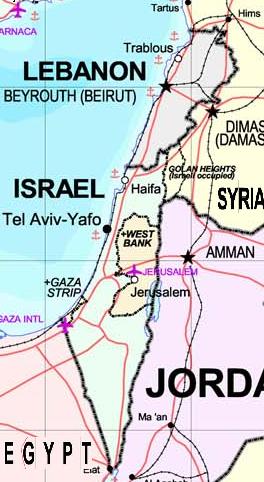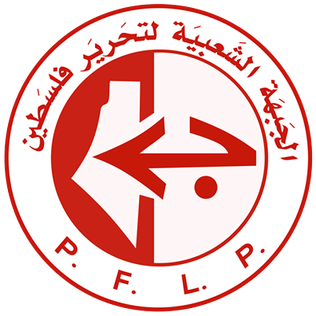
Yasser Arafat, also popularly known by his kunya Abu Ammar, was a Palestinian political leader. He was chairman of the Palestine Liberation Organization (PLO) from 1969 to 2004, President of the State of Palestine from 1989 to 2004 and President of the Palestinian Authority (PNA) from 1994 to 2004. Ideologically an Arab nationalist and a socialist, Arafat was a founding member of the Fatah political party, which he led from 1959 until 2004.

The Popular Front for the Liberation of Palestine – General Command or PFLP-GC is a Palestinian nationalist militant organisation based in Syria. It is a member of the Palestine Liberation Organization (PLO).

The 1982 Lebanon War, also called the Second Israeli invasion of Lebanon, began on 6 June 1982, when Israel invaded southern Lebanon. The invasion followed a series of attacks and counter-attacks between the Palestine Liberation Organization (PLO) operating in southern Lebanon and the Israeli military, which had caused civilian casualties on both sides of the border. The Israeli military operation, codenamed Operation Peace for Galilee, was launched after gunmen from the Abu Nidal Organization attempted to assassinate Shlomo Argov, Israel's ambassador to the United Kingdom. Israeli Prime Minister Menachem Begin blamed the PLO, using the incident as a casus belli. It was the second invasion of Lebanon by Israel, following the 1978 South Lebanon conflict.

The Lebanese Civil War was a multifaceted armed conflict that took place from 1975 to 1990. It resulted in an estimated 150,000 fatalities and led to the exodus of almost one million people from Lebanon.

The 1978 South Lebanon conflict, also known as the First Israeli invasion of Lebanon and codenamed Operation Litani by Israel, began when Israel invaded southern Lebanon up to the Litani River in March 1978. It was in response to the Coastal Road massacre near Tel Aviv by Palestinian militants based in Lebanon. The conflict resulted in the deaths of 1,100–2,000 Lebanese and Palestinians, 20 Israelis, and the internal displacement of 100,000 to 250,000 people in Lebanon. The Israel Defense Forces gained a military victory against the Palestine Liberation Organization (PLO) as the latter was forced to withdraw from southern Lebanon, preventing it from launching attacks on Israel from across its land border with Lebanon. In response to the outbreak of hostilities, the United Nations Security Council adopted Resolution 425 and Resolution 426 on 19 March 1978, which called on Israel to immediately withdraw its troops from Lebanon and established the United Nations Interim Force in Lebanon (UNIFIL).

Black September, also known as the Jordanian Civil War, was an armed conflict between Jordan, led by King Hussein, and the Palestine Liberation Organization (PLO), led by chairman Yasser Arafat. The main phase of the fighting took place between 16 and 27 September 1970, though certain aspects of the conflict continued until 17 July 1971.
The War of the Camps, was a subconflict within the 1984–1990 phase of the Lebanese Civil War, in which the Sunni Palestinian refugee camps in Beirut were besieged by the Shia Amal militia.

The Israeli–Lebanese conflict, or the South Lebanon conflict, is a long-running conflict involving Israel, Lebanon-based paramilitary groups, and sometimes Syria. The conflict peaked during the Lebanese Civil War. In response to Palestinian attacks from Lebanon, Israel invaded the country in 1978 and again in 1982. After this it occupied southern Lebanon until 2000, while fighting a guerrilla conflict against Shia paramilitaries. After Israel's withdrawal, Hezbollah attacks sparked the 2006 Lebanon War. A new period of conflict began in 2023, leading to the 2024 Israeli invasion of Lebanon.

The South Lebanon conflict was an armed conflict that took place in Israeli-occupied southern Lebanon from 1982 or 1985 until Israel's withdrawal in 2000. Hezbollah, along with other Shia Muslim and left-wing guerrillas, fought against Israel and its ally, the Catholic Christian-dominated South Lebanon Army (SLA). The SLA was supported militarily and logistically by the Israel Defense Forces and operated under the jurisdiction of the Israeli-backed South Lebanon provisional administration, which succeeded the earlier Israeli-backed Free Lebanon State. Israel officially names the conflict the Security Zone in Lebanon Campaign and deems it to have begun on 30 September 1982, after the end of its "Operation Peace for Galilee". It can also be seen as an extension of the Lebanese Civil War (1975–1990).

The Lebanese National Resistance Front, best known by its Arabic acronym, ‘Jammoul’ (جمول), was a leftist alliance active in Lebanon in the 1980s. It acted as a successor to the Lebanese National Movement, which ceased to exist after the Israeli invasion of Lebanon.

Palestinian fedayeen are militants or guerrillas of a nationalist orientation from among the Palestinian people. Most Palestinians consider the fedayeen to be freedom fighters, while most Israelis consider them to be terrorists.

Ainab, is a town on the western slopes of Mount Lebanon overlooking Beirut. It is in the Aley District of the Mount Lebanon Governorate 25 kilometres (16 mi) from Beirut, on the road South from Aley.
The Front for the Liberation of Lebanon from Foreigners (FLLF), or Front pour la Libération du Liban des Étrangers (FLLE) in French, was a formerly obscure underground terrorist organization that surfaced in Lebanon at the early 1980s.

The Palestinian insurgency in South Lebanon was a multi-sided armed conflict initiated by the Palestine Liberation Organization (PLO) against Israel in 1968 and against Lebanese Christian militias in the mid-1970s. PLO's goals evolved during the insurgency; by 1977, its goal was to pressure Israel into allowing a Palestinian state in the West Bank and Gaza Strip. In 1982, Israel invaded Lebanon and expelled the PLO, thereby ending the insurgency.

The Popular Front for the Liberation of Palestine is a secular Palestinian Marxist–Leninist and revolutionary socialist organization founded in 1967 by George Habash. It has consistently been the second-largest of the groups forming the Palestine Liberation Organization (PLO), the largest being Fatah.

The Democratic Front for the Liberation of Palestine is a secular Palestinian Marxist–Leninist and Maoist organization. It is also frequently referred to as the Democratic Front, or al-Jabha al-Dīmūqrāṭiyya. It is a member organization of the Palestine Liberation Organization, the Alliance of Palestinian Forces and the Democratic Alliance List.

During the 1982 Lebanon War, the city of Beirut was besieged by Israel following the breakdown of the ceasefire that had been imposed by the United Nations amidst the Lebanese Civil War. Beginning in mid-June, the two-month-long siege resulted in the expulsion of the Palestine Liberation Organization (PLO) from Beirut and the rest of Lebanon.
The Battle of Tripoli was a major battle during the middle of the Lebanese Civil War in late 1983. It took place in the northern coastal city of Tripoli between pro-Syrian Palestinian militant factions and the Palestine Liberation Organization (PLO) led by Yassir Arafat. It resulted in the withdrawal of PLO and mostly ended their involvement in the war.












